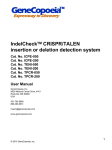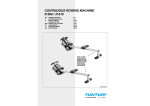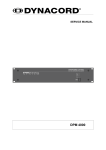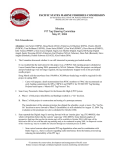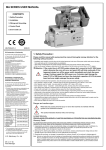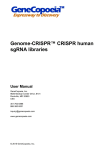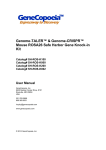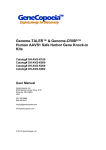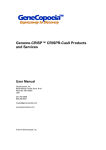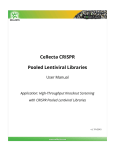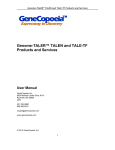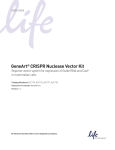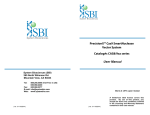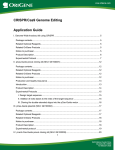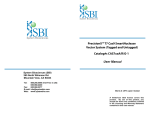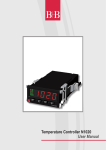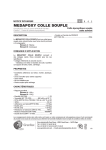Download IndelCheck™ detection system user manual
Transcript
IndelCheckTM CRISPR/TALEN insertion or deletion detection system Cat. No. ICPE-050 Cat. No. ICPE-200 Cat. No. TENI-050 Cat. No. TENI-200 Cat. No. TPCR-050 Cat. No. TPCR-200 Cat. No. IC007 Cat. No. IC008 User Manual GeneCopoeia, Inc. 9620 Medical Center Drive, #101 Rockville, MD 20850 USA 301-762-0888 866-360-9531 [email protected] www.genecopoeia.com © 2015 GeneCopoeia, Inc. 1 USER MANUAL IndelCheckTM CRISPR/TALEN insertion or deletion detection system I. Introduction ......................................................................................................................................3 II. Contents and storage.....................................................................................................................4 III. Protocol overview ...........................................................................................................................6 IV. Experimental Procedures ..............................................................................................................7 1.Primer design ...................................................................................................................7 2.Sample preparation ..........................................................................................................7 3.Target site PCR and product processing........................................................................8 4.Denaturation and re-annealing......................................................................................10 5.Digest with T7 Endonuclease.......................................................................................10 I 6.Gel analysis...................................................................................................................10 7.Sequence verification .....................................................................................................11 V. Notes and Troubleshooting..........................................................................................................12 VI. Appendix ......................................................................................................................................14 VII. Limited Use License and Warranty............................................................................................20 2 IndelCheckTM CRISPR/TALEN insertion or deletion detection system I. Introduction CRISPR/TALEN introduced double-stranded breaks (DSBs) at desired target sites can be repaired by nonhomologous end joining (NHEJ), which is error prone and typically results in small insertions or deletions (indels) near the DSB. The target region is PCR-amplified, and the PCR products are denatured and re-annealed to allow mismatched DNA to form, such as wildtype/indel mutation mismatches or indel mutation 1/indel mutation 2 mismatches. The re-annealed PCR fragments are incubated with T7 endonuclease I, which recognizes and cleaves mismatched DNA. If two shorter bands of the predicted size are generated, it usually means that CRISPR/TALEN has successfully introduced indel mutations at the targeted chromosomal site. Figure 1. CRISPR or TALEN functional validation using the mismatch cleavage assay 3 IndelCheckTM CRISPR/TALEN insertion or deletion detection system The IndelCheckTM CRISPR/TALEN insertion or deletion detection system (ICPE-050, ICPE-200) is a complete system designed to simplify your validation or screening workflow. It includes the Target Site PCR kit (TPCR-050, TPCR-200), the T7 Endonuclease I Assay kit (TENI-050, TENI200) and the Target Sitre PCR Cloning ki t(IC007, IC008). All components are optimized together for the best performance. The Target Site PCR kit is optimized for robust amplification of the target site. With the proprietary lysis buffer included, genomic DNA isolation is no longer required. The kit contains the high efficiency and high fidelity SuperHeRo DNA polymerase, which produces both blunt-end and sticky-end PCR products compatible with a variety of sequencing vectors. GeneCopoeia also provides the target site PCR primer design and synthesis. Go to our website for more details. The T7 Endonuclease I Assay kit contains T7 endonuclease I, which detects and cleaves heteroduplex DNA. It also contains positive controls for both target PCR and indel mismatch cleavage. The Target Sitre PCR Cloning kit is a cloning system composed of Solution I & II. It clones target site PCR products into linearized vector pTSC for sequence verification. Check primers of pTSC vector are also provided. Advantages • Complete system to simplify your CRISPR/TALEN validation, knockout clone screening and sequence verification. • Robust amplification for the target site PCR. No genomic DNA isolation is required • Easy to use T7 endonuclease I assay with optimized conditions and positive control 4 IndelCheckTM CRISPR/TALEN insertion or deletion detection system II. Contents and Storage IndelCheckTM CRISPR/TALEN insertion or deletion detection system (ICPE-050, ICPE-200) The T7 endonuclease I assay kit comes in two sizes: 50-Reaction Kit (Catalog No. TENI-050) 200-Reaction Kit (Catalog No. TENI-200) Quantity 50 reactions 200 reactions Shipping temperature Storage temperature T7 Endonuclease I (2U/μL) 100μL 400μL Ice pack -20°C Stable for at least 12 months 10× T7EN Buffer 100μL 400μL Ice pack -20°C Stable for at least 12 months 200μL 800μL Ice pack -20°C Stable for at least 12 months Quantity 50 reactions 200 reactions Shipping temperature Storage temperature 650 μL × 2 650 μL × 8 Ice pack -20°C Stable for at least 12 months 5XPCR Buffer 250 μL 1 mL Ice pack -20°C Stable for at least 12 months 5XEnhancer 250 μL 1 mL Ice pack -20°C Stable for at least 12 months 20mM Mg2+ 125 μL 500 μL Ice pack -20°C Stable for at least 12 months 25mM dNTP 10 μL 40 μL Ice pack -20°C Stable for at least 12 months 12.5 μL 50 μL Ice pack -20°C Stable for at least 12 months Content Digestion reagents Control reagents Control template & primer mix The target site PCR kit comes in two sizes: 50-Reaction Kit (Catalog No. TPCR-050) 200-Reaction Kit (Catalog No. TPCR-200) Content Lysis Buffer NEW SuperHeRo DNA polymerase 5 IndelCheckTM CRISPR/TALEN insertion or deletion detection system The target site PCR cloning kit comes in one sizes: 20-Reaction Kit (Catalog No. IC007) 100-Reaction Kit (Catalog No. IC008) Quantity 20 reactions 100 reactions Shipping temperatur e Storage temperature pTSC Vector (linearized) 20 μL 100 μL Ice pack -20°C Stable for at least 12 months Solution I 100 μL 500μL Ice pack -20°C Stable for at least 12 months Solution II 200 μL 1 mL Ice pack -20°C Stable for at least 12 months Control Insert 20 μL 100μL Ice pack -20°C Stable for at least 12 months pTSC_F Primer 20 μL 100 μL Ice pack -20°C Stable for at least 12 months 20 μL 100 μL Ice pack -20°C Stable for at least 12 months Content pTSC_R Primer Important note: . Store all components at –20℃ upon receipt. Materials required but not supplied The following materials are required but not supplied: ddH2O. Avoid using autoclaved H2O. The recycled steam in some autoclaves can introduce contaminants that may interfere with PCR. Target site PCR primers specific to target site(s) with Tm ≥ 60°C The primers should flank the TALEN or sgRNA target site and generate an amplicon of approximately 500-800 bp with the TALEN or sgRNA target site offset from the center by approximately100 bp. Make sure the primers are specific for the intended site. Avoid using primers that contain inosine. Avoid to have potential SNP sites or sequence differences between alleles in your target region. NOTE: We highly recommend you to obtain sequence information of the target site of you cell line before primer design and any other experiment. It is possible for mammallian cells, which are usually dipoid, to have sequence differences between alleles. This may cause false positive results when using T7 endonuclease I to digest negative controls. Such sites should be avoided when designing target PCR primers. See Appendix 4. for further instructions on checking potential SNP sites using online tools. *GeneCopoeia also provides design and synthesis services for sequence-specific target site PCR primers. 6 IndelCheckTM CRISPR/TALEN insertion or deletion detection system IV. Protocol Overview Cell lysis Genomic DNA extraction (Optional) Target site PCR from lysate or purified genomic DNA Gel purification (Optional) Denaturation and re-annealing Ligate to pTSC vector T7 Endonuclease I digestion Sequence-verify modifications Electrophoresis and analysis 7 IndelCheckTM CRISPR/TALEN insertion or deletion detection system IV. Experimental Procedures This section provides instructions for validating CRISPR sgRNA or TALEN chromosomal cleavage activity using the IndelCheckTM CRISPR/TALEN insertion or deletion detection system. In addition to the steps shown in the protocol overview, we also provide brief instructions for PCR primer design and genomic DNA extraction. If you stop before completing all the steps, please store your PCR or digestion products at -20℃ until the next step. Avoid repeated freeze-thaw cycles. We recommend that first time users perform a positive control PCR reaction using the control reagents in the kit. This PCR product can serve as a control for denaturation and re-annealing, as well as mismatch digestion steps. 1. Primer Design 1) Target site PCR primers should have a Tm value of no less than 62℃ 2) For optimum results, the amplicon size range should be approximately 500~800bp. 3) Design primers so that the CRISPR sgRNA or TALEN target site is offset from the center of the PCR product by approximately 100 bp. This ensures being able to readily resolve the cleavage products on the gel. 2. Sample Preparation Option 1: Genomic DNA extraction a) Harvest cells (no fewer than ~106 cells per well). b) Extract genomic DNA using your method of choice or following the provided protocol of extraction kit manufacturer. Make sure the concentration of genomic DNA solution is above 25 ng/μL. Option 2: Cell lysate preparation a) Collect cells from cell culture dish, 6- well plate or 96-well plate. Centrifuge at 3000 rpm at 4℃ for 5 min and carefully remove the supernatant. b) Add 300μL 1×PBS. Pipette gently to suspend cells. Centrifuge at 3000 rpm at 4℃ for 5 min and remove the supernatant. c) Add 300μL 1×PBS and resuspend cells. Sample the suspension to calculate the cell number if necessary. Centrifuge at 3000 rpm at 4℃ for 5 min and remove the supernatant as completely as possible. Proceed to lyse or store the pellet at -80℃. d) Add 25μL Lysis Buffer and lyse cells at 65°C for 15 min, then 95°C for 10 min. Quickly put it on ice afterward. 8 IndelCheckTM CRISPR/TALEN insertion or deletion detection system NOTE: The volume of Lysis Buffer can be adjusted basing on the cell number. At least 50,000 and no more than 5×105 cells are recommended for use in 25 μL Lysis Buffer. For confluent cells of a well of 6-well plate, add 200 μL~600 μL Lysis Buffer. For confluent cells of a well of 96-well plate, add 50-100 μL Lysis Buffer. For amplifying fragment > 1 kb, we suggest prolonging the cell lysis at 65°C for 40 min, but no more than 1h. However, It is not not necessary to obtain complete cell lysis in most experiments. The remaining cells can be stored at -80℃ or for continued culture. e) Frozen centrifuge at 12000 rpm for 1 min. NOTE: Too much floc after centrifuge suggests too little lysis occurred. After transferring the suspension to another tube, the precipitate can be resuspended by adding another 25 μL Lysis Buffer. f) Proceeded to PCR reaction with Target PCR kit. The cell lysate can be stored at 4 ℃ for no more than one week or -20 ℃ for several months until use. 3. Target PCR and product processing 1) Target PCR a) For PCR from extracted genomic DNA, prepare a Master Mix with target PCR primers flanking the insert as follows: Item Amount 5X PCR Buffer 5 μL 5X Enhancer (optional) 5 μL 50-200 ng 2 μL 0.2 μL 0.25 μL 2.5 μL to 25 μL 25 μL genomic DNA Target PCR primer pair(5 μM) 25mM dNTP SuperHeRo DNApolymerase (5U/μL) 20mM Mg2+ ddH2O Final 9 IndelCheckTM CRISPR/TALEN insertion or deletion detection system b) For PCR from lysate, prepare a Master Mix with target PCR primers as follows: Amount Item 5X PCR Buffer 5 μL 5X Enhancer (optional) 5 μL 1* μL 2 μL 0.2 μL 0.25 μL 2.5 μL to 25 μL 25 μL Lysate Target PCR primer pair (5 μM) 25mM dNTP SuperHeRo DNApolymerase (5U/μL) 20mM Mg2+ ddH2O Final *To avoid insufficient PCR amplification, adjust the volume of cell lysate based on the cell number. to ensure that no less than 2000 copies of template are present in the reaction. For example, for HT1080 cells, which contains 2 copies of each chromosome, at least 1000 lysed cells are needed in a PCR reaction. To get a bright and clear band on agarose gel, about 10,000 lysed cells are needed. NOTE: See Appendix 3. for PCR system for the control mix. c) Proceed with PCR using the following program 94℃ 5 min 94℃ 30 s 58℃ 30 s 72℃ 1 min 72℃ 5 min 1 cycle 35 cycs 1 cycle NOTE: PCR should produce a sufficiently high yield of a SINGLE amplified band of the correct size. We strongly recommend use of a high fidelity DNA polymerase to reduce the amount of base misincorporation during PCR and subsequent false positives. The PCR product can be directly used as the substrate for T7 Endonuclease I digestion. 10 IndelCheckTM CRISPR/TALEN insertion or deletion detection system 2) Purification or gel extraction of correct-sized band from non-specific PCR background. See Appendix 2 for using gel purification to optimize cleavage of non-specific amplicons 4. Denaturation and re-annealing 1) For purified genomic PCR product: DNA (>25ng/μL) 200~500 ng 10X T7EN Buffer 2 μL Add up to 19 μL 19 μL Nuclease-free water Total For PCR products amplified with GeneCopoeia target PCR kit, combine the following Unpurified PCR product Nuclease-free water Total 200~500 ng(5~19μL) Add up to 19 μL 19 μL 2) Mix and centrifuge for a few seconds. 3) Heat at 95℃ for 5 minutes. 4) Reanneal by allowing the denatured PCR products to cool down to RT. 5. Digest with T7 Endonuclease I 1) Add 1μL of 2U/μL T7 Endonuclease I. 2) Incubate at 37℃ for 20-60 minutes. 6. Gel analysis 1) Add 1/10 volume of 10 × loading buffer [with 0.1% SDS] to each reaction and mix thoroughly. 2) Load half of the mixture into the well of 2% agarose/EtBr gel and run in TAE or TBE buffer. 3) Also load a 100bp DNA ladder (#M01010A) as a size reference marker in one of the adjacent wells. Run the gel at 5 V/cm – 11 V/cm until the bromophenol blue reach 2/3 of the length of the gel. 11 IndelCheckTM CRISPR/TALEN insertion or deletion detection system 1 2 3 4 M Gene PCR Product NR0B1 429 T7 Endonuclease I 147 282 Figure 2. T7 Endonuclease I assay. Lane 1: PCR product from negative control cells, digested with T7 Endonuclease I. Lane 2: PCR product from negative control cells, undigested. * * Lane 3: PCR product from sample cells, digested with T7 Endonuclease I. Digestion yields 3 bands: 1 unmodified + 2 cleavage products of predicted sizes (red asterisks). Lane 4: PCR product from sample cells, undigested. Lane M: 100bp plus DNA ladder (#M01010A). NOTE: See Appendix 3. for T7 endonuclease I assay of control. 7. Sequence verification (following step 3) 1) Rrepare Solution I reaction system as follows: Target site PCR product 0.1 -0.3 5 Solution I ddH2O up to 10 Total 10 pmol μL ddH2O μL 2) Incubate in 37℃ for 30 minutes, then at 75℃ for 10 minutes; 3) Add 1μL pTSC vector to product of step 2), then add 9μL solution II. Mix gently, and allow reaction to continue at 16℃for 30 minutes (prolonged reaction time is recommended); 4) Add 3μL of step 3) to 100μL DH5a conpetent cells and ice-bath for 30 minutes; 5)Heat at 42℃ for 45 seconds, then place in an ice-bath for 2 minutes; 6)Add 400μL SOC medium, shake at 37℃ for 1 hour; 7)Plate step 6) on L-Agar plate containing X-Gal、IPTG & Ampicillin, then count the numbers of white and blue single colonies; 8)Pick the white colonies for sequencing (or PCR-verify the length of insertion). 12 IndelCheckTM CRISPR/TALEN insertion or deletion detection system VI. Notes and Troubleshooting Cleavage troubleshooting Problem Non-specific cleavage bands are observed No cleavage products observed Possible Causes Non-specific PCR amplification Recommended Solution • Do gel purification to ensure that your amplicons are single bands (See Figure 4 in Appendix). • Optimize PCR primers on untreated genomic DNA or cell lysates. • Optimaze PCR condition. • If no cleavage is observed for all samples including the positive control, add MnCl2 at a final concentration of 10mM to enhance T7 Endonuclease I activity. • Ensure that samples are incubated at 37℃. • Advoid treating with T7 Endonuclease I more than 1.5 hour. Low T7 Endonuclease I activity Incorrect reaction temperature Reaction time too long • Nonspecific nuclease activity is observed Poor annealing operation PCR is introducing mutations Low positive rate of modification DNA bands are too weak to be observed Insufficient amount of DNA loaded on gel Perform denaturalization and annealing in heated water. Let the reaction cool down naturelly with the water. • Perform the denaturalization and annealing step in a PCR machine. as follows: (1)95℃ 5min (2)94℃(-2℃/cycle), 10-20 sec (3)93℃(-2℃/cycle), 10-20sec and go to step (2),34 cycles • Be sure to use a high-fidelity polymerase for PCR amplification • If possible, optimize the conditions of your genome editing experiment (e.g., design new CRISPR sgRNA or TALENs). • Be sure to load enough DNA to enable ready visualization on the gel. Also, load equal amounts of total PCR product DNA in each lane. 13 IndelCheckTM CRISPR/TALEN insertion or deletion detection system Target site PCR troubleshooting Problem Possible Causes Suboptimal PCR conditions Concentration of PCR template is too low Recommended Solution • Analyze the sequence of your target. If the GC content is lower than 40%, do not add Enhancer in the PCR reaction. • Extract and purify genomic DNA to better control the template concentration. • Remove PBS as completely as possible before adding Lysis Buffer, or the remaining PBS will dilute the lysis buffer. • Caluculate the cell number by hemocytometer or cellometer before lysing the cells. Adjust the volume of lysis buffer according to the cell number. • Check if the primers match with the template correctly. • Increase the annealing tempture to 0~5℃ above the Tm value. • Check the design of PCR primers for possible non-specific binding. If necessary, redesign primers to improve specifity. • Decrease the volume of polymerase to 0.2 μL (1U) • Dilute template 2 or more fold and repeat the PCR. • Decrease the volume of polymerase to 0.2 μL (1U) No expected bands Incomplete lysis Poor PCR primer design Suboptimal PCR conditions Non-specific bands Poor PCR primer design Too much polymerase Concentration of PCR template is too high Smear Too much polymerase 14 IndelCheckTM CRISPR/TALEN insertion or deletion detection system VII. Appendix 1. Example of using IndelCheckTM CRISPR/TALEN indel detection system to validate CRISPR sgRNA or TALEN cleavage activity (A) M (B) M - + - + * * * * T7 Endonuclease I Panel Target Gene PCR Product A NR4A1 775 428 347 B ESRRA 791 267 524 Figure 3. T7 Endonuclease I digestion products of amplicons derived from human genomic DNA. Control cells (-) should only have a larger band corresponding to the uncut genomic amplicon. Sample cells (+) transfected with indicated Cas9-sgRNA have a larger band and smaller bands corresponding to the DNA fragments resulting from the cleavage of the genomic amplicon by T7 Endonuclease I. 2. Example of using gel purification to optimize cleavage of non-specific amplicons 1 2 3 4 5 Target Gene PCR Product NR0B1 429 bp T7 Endonuclease I 127 bp 302 bp Figure 4. Cleavage comparisom between gel-purified and unpurified non-specific target site PCR products. Lane1: Gel extracted PCR product, digested by T7 Endonuclease I Lane2: Gel extracted PCR product, undigested Lane3: Unpurified PCR product with non-specific bands, digested by T7 Endonuclease I Lane4: Unpurified PCR product with non-specific bands, undigested Lane5: 100bp plus DNA ladder (#M01010A) 15 IndelCheckTM CRISPR/TALEN insertion or deletion detection system 3. Procedures for control target PCR and T7 endonuclease I assay using the control template & primer mix 1) Control PCR a) Prepare control PCR using the following system. Amount Item 5 × PCR Buffer 5 μL 5 × Enhancer (optional) 5 μL Control template & primer mix 4 μL 0.2 μL 0.25 μL 2.5 μL to 25 μL 25 μL 25mM dNTP SuperHeRo DNApolymerase (5U/μL) 20mM Mg2+ ddH2O Final b) Proceed with PCR using the following program. 94℃ 5 min 94℃ 30 s 58℃ 30 s 72℃ 1 min 72℃ 5 min 1 cycle 35 cycs 1 cycle 2) Denaturation and re-annealing a) For PCR products amplified with GeneCopoeia target PCR kit, combine the following Unpurified PCR product Nuclease-free water Total 200~500 ng(5~19μL) Add up to 19 μL 19 μL 16 IndelCheckTM CRISPR/TALEN insertion or deletion detection system b) Mix and centrifuge for a few seconds. c) Heat at 95℃ 5 minutes. d) Reanneal by allowing the denatured PCR products cool down to RT. 3) Digest with T7 Endonuclease I a) Add 1μL of 2U/μL T7 Endonuclease I. b) Incubate at 37℃ for 20-60 minutes. 4) Gel analysis a) Add 1/10 volume of 10 × loading buffer [with 0.1% SDS] to each reaction and mix thoroughly. b) Load half of the mixture into the well of 2% agarose/EtBr gel and run in TAE or TBE buffer. c) Also load a 100bp DNA ladder (#M01010A) as a size reference marker in one of the adjacent wells. Run the gel at 5 V/cm until the bromophenol blue has migrated 2/3 of the length of the gel. M 2 1 Gene PCR Product control 520 T7EI 180 330 Figure 3. T7 Endonuclease I assay result for control Lane M: 100bp plus DNA ladder (#M01010A). Lane 1: unpurificated PCR product from control,undigested Lane 2: unpurificated PCR product from control, digested 17 IndelCheckTM CRISPR/TALEN insertion or deletion detection system 4. Use the Control insert in Target Site PCR Cloning kit for positive control of cloning Control Insert 0.1 -0.3 5 Solution I ddH2O up to 10 Total 10 pmol μL ddH2O μL 2) Incubate at 37℃ for 30 minutes, then at 75℃ for 10 minutes; 3) Add 1μL pTSC vector to product of step 2), then add 9μL solution II. Mix gently, and allow reaction to continue at 16℃for 30 minutes (prolonged reaction time is recommended); 4) Add 3μL of step 3) to 100μL DH5a conpetent cells and ice-bath for 30 minutes; 5)Heat at 42℃ for 45 seconds, then ice-bath for 2 minutes; 6)Add 400μL SOC medium, then shake at 37℃ for 1 hour; 7)Plate step 6) on L-Agar plate containing X-Gal、IPTG & Ampicillin, then count the numbers of white and blue single colonies; 8)Pick the white colonies for sequencing (or PCR-verify the length of insertion). 5. pTSC vector primer information(provided in kit): • pTSC_F:5'-ttcacacaggaaacagctatgacc-3' • pTSC_R:5'-cagggttttcccagtcacgac-3' 6. Suggested sequence primer(not provided): •Forward primer: RV-M: 5'-GAGCGGATAACAATTTCACACAGG-3' M13R(-48): 5'-AGCGGATAACAATTTCACACAGGA-3' PQE-F: 5'-TGAGCGGATAACAATTTCAC-3' •Reverse primer: PMAL-C2X-R: 5'-CTGCAAGGCGATTAAGTTGG-3' M13F(-47): 5'-CGCCAGGGTTTTCCCAGTCACGAC-3' 18 IndelCheckTM CRISPR/TALEN insertion or deletion detection system 5. Search for potential SNP sites using online tools Mammalian cells contain at least 2 copies of every chromosome, one copy from the mother, and the other from the father. So although most stretches of the chromosome will be identical to one another, it is possible to have some variations between them-in the forms of SNPs or other base pair differences in your target region sequence. Also, some tumor genes, such as P53, tend to have lots of mutations. So even in the negative control, it is possible to get T7 cutting from PCR product denaturion and reannealing. This is why when designing target primers, your design strategy should include avoiding SNPs in the first place. We highly recommend you obtain sequence information of the target site of your cell line before primer design and any other experiment. NCBI provides a tutorial for searching for SNP information of a gene. We offer a briefdescription of the process here. BY GENE NAME 1. Search the Gene database with the gene name. If you know the gene symbol and species, enter them as follows: tpo[sym] AND human[orgn] 2. Click on the desired gene. 19 IndelCheckTM CRISPR/TALEN insertion or deletion detection system 3. In the list of Links on the right, click "GeneView in dbSNP". If the link is not present, no SNPs are currently linked to this gene. 4. For human genes, another option is to go to the variation section (Click on Variation in the table of contents in the upper right), and follow links to Variation Viewer for either the GRCh37/hg19 or GRCh39/h38 assemblies, to the 1000 Genomes Browser, ClinVar and more. 20 IndelCheckTM CRISPR/TALEN insertion or deletion detection system Figure 4. Example of SNP Geneview Report on NCBI. Check column "mRNA pos" for your SNP site of interest. Check column "Chr, position" or "db SNP rs# cluster id" for the sequence of the site of interest. 21 IndelCheckTM CRISPR/TALEN insertion or deletion detection system VIII. Limited Use License and Warranty Limited use license Following terms and conditions apply to use of the IndelCheck TM CRISPR/TALEN insertion or deletion detection system. If the terms and conditions are not acceptable, the Product in its entirety must be returned to GeneCopoeia within 5 calendar days. A limited End-User license is granted to the purchaser of the Product. The Product shall be used by the purchaser for internal research purposes only. The Product is expressly not designed, intended, or warranted for use in humans or for therapeutic or diagnostic use. The Product must not be resold, repackaged or modified for resale, or used to manufacture commercial products or deliver information obtained in service without prior written consent from GeneCopoeia. Use of any part of the Product constitutes acceptance of the above terms. Limited warranty GeneCopoeia warrants that the Product meets the specifications described in the accompanying Product Datasheet. If it is proven to the satisfaction of GeneCopoeia that the Product fails to meet these specifications, GeneCopoeia will replace the Product. In the event a replacement cannot be provided, GeneCopoeia will provide the purchaser with a refund. This limited warranty shall not extend to anyone other than the original purchaser of the Product. Notice of nonconforming products must be made to GeneCopoeia within 30 days of receipt of the Product. GeneCopoeia’s liability is expressly limited to replacement of Product or a refund limited to the actual purchase price. GeneCopoeia’s liability does not extend to any damages arising from use or improper use of the Product, or losses associated with the use of additional materials or reagents. This limited warranty is the sole and exclusive warranty. GeneCopoeia does not provide any other warranties of any kind, expressed or implied, including the merchantability or fitness of the Product for a particular purpose. GeneCopoeia is committed to providing our customers with high-quality products. If you should have any questions or concerns about any GeneCopoeia products, please contact us at 301-7620888. © 2015 GeneCopoeia, Inc. For Research Use Only. Trademark: GeneCopoeiaTM (GeneCopoeia, Inc.), IndelCheckTM © 2015 GeneCopoeia, Inc. CV-1112115 22






















